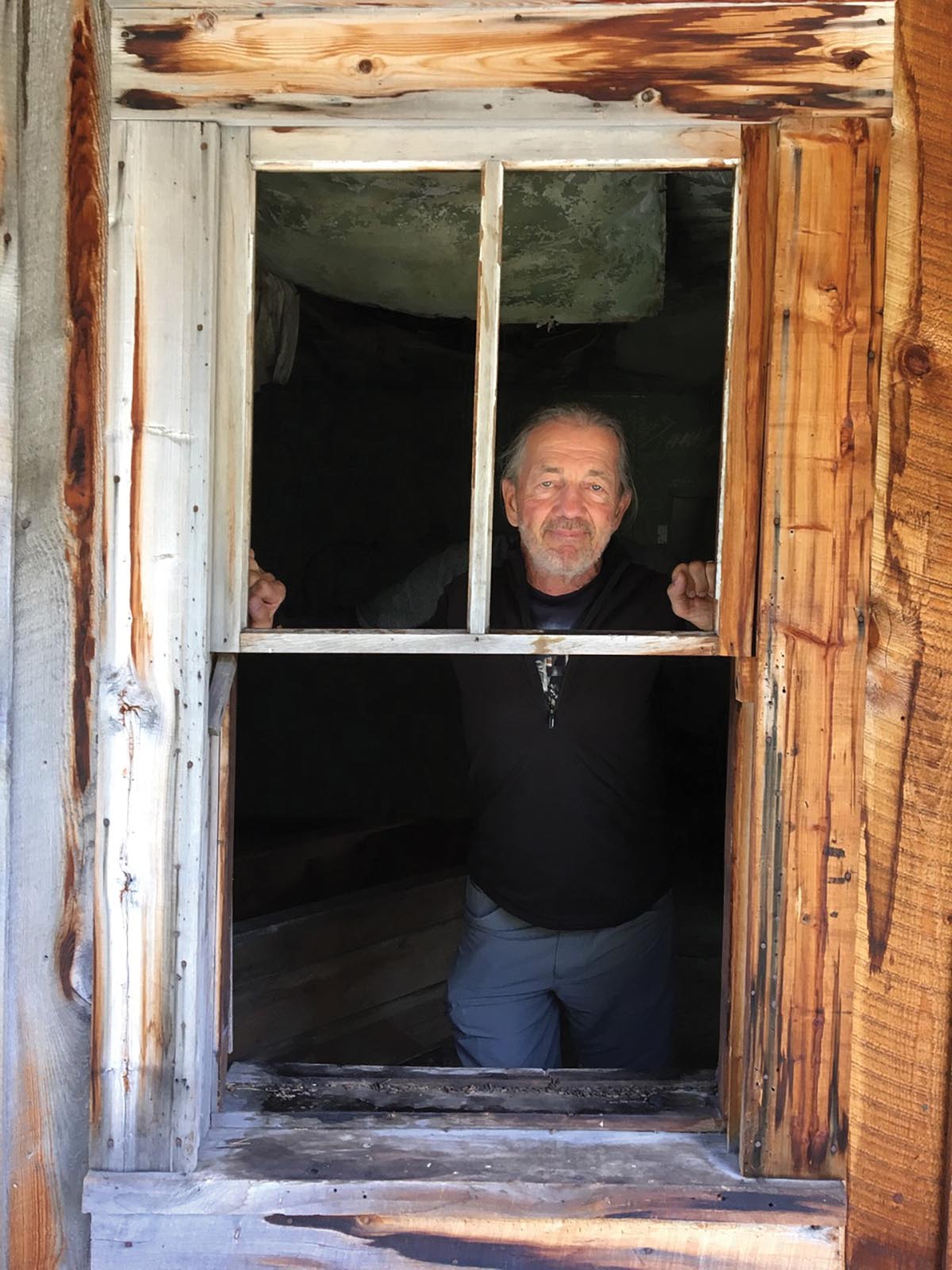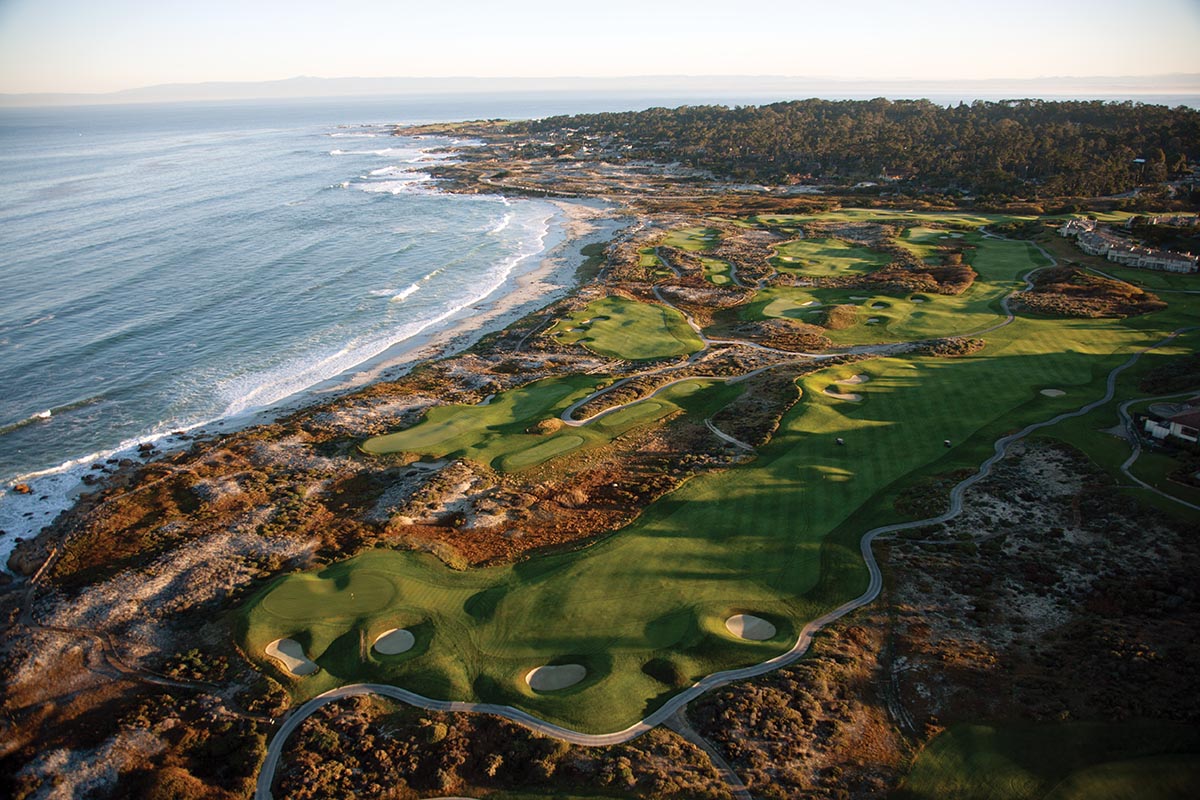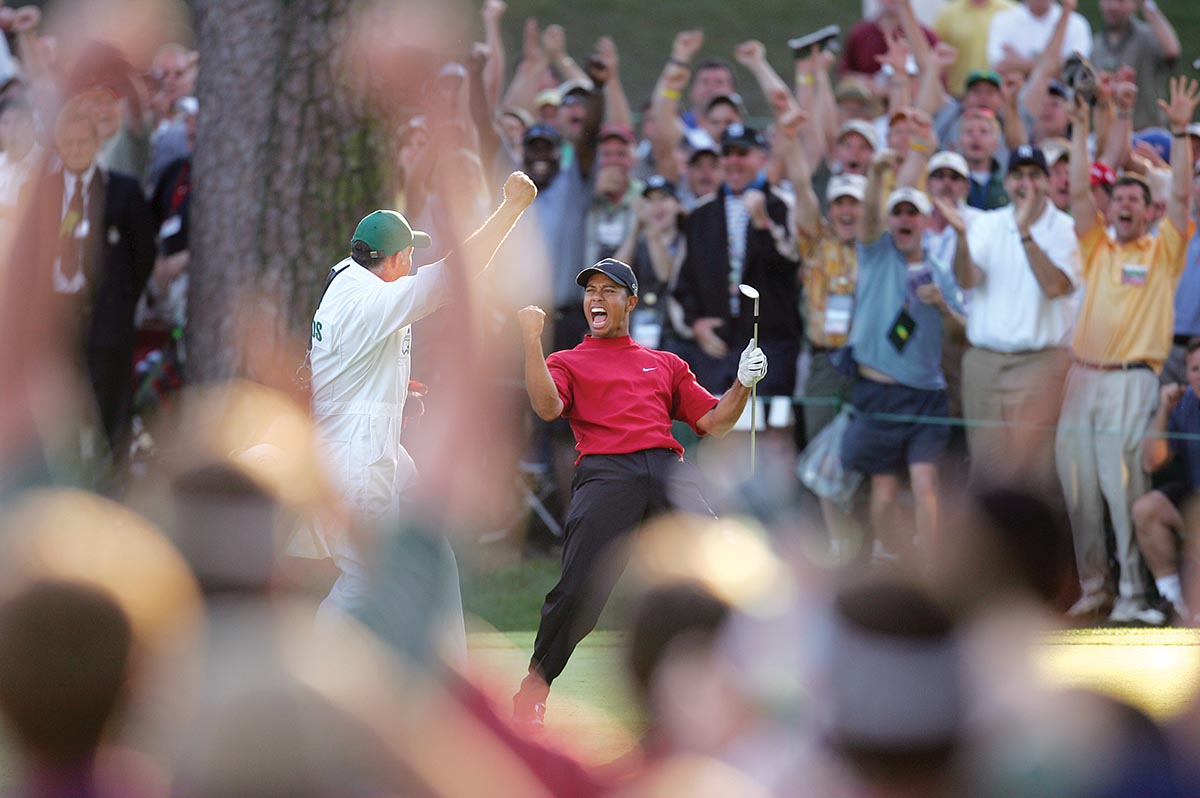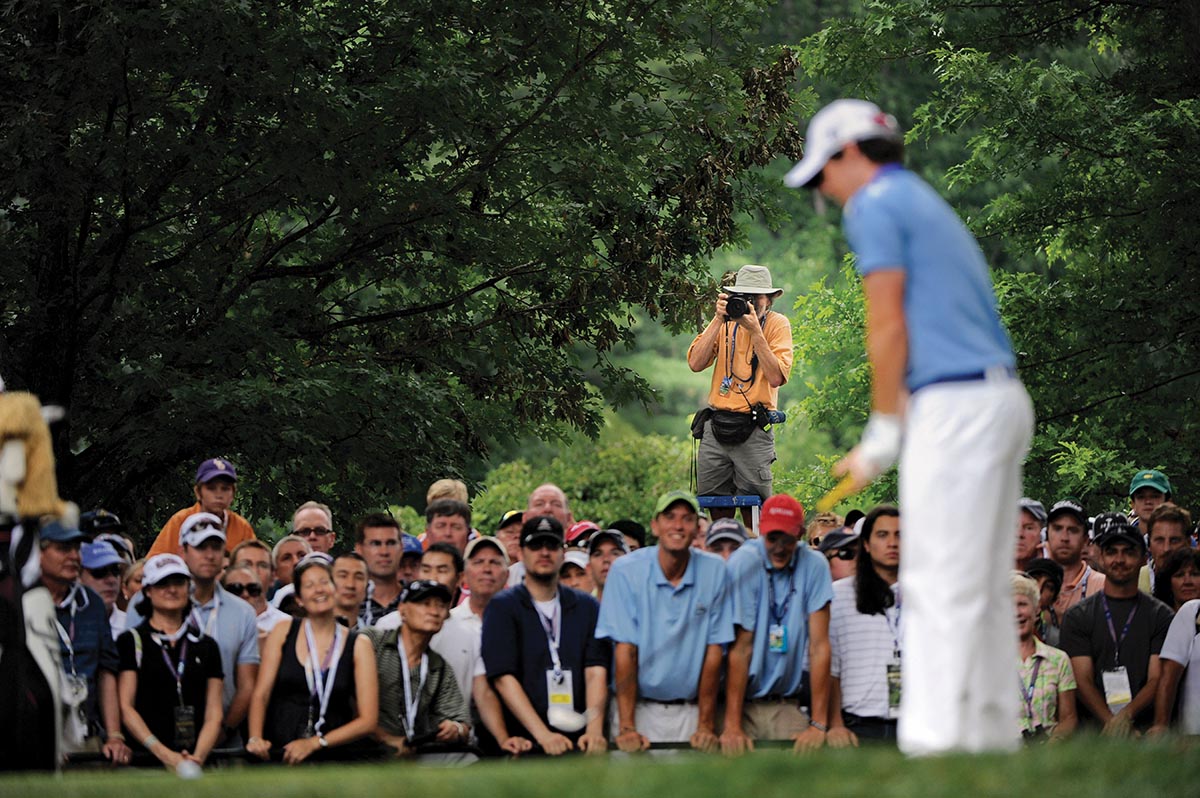Sinking the Shot
Stephen Szurlej is a master at being in the right place at the right time.
• May 2024 issue
It was a brilliantly sunny August day in Akron, Ohio. Golf photographer Stephen Szurlej, who had been following Tiger Woods outpacing the competition at the World Golf Championship, was planning his next shot. Woods, long one of Szurlej’s favorite subjects, hammered a monster tee shot, and his ball came to rest in the high rough just off the fairway of the Firestone Country Club. As the course marshals set up a rope to keep the approaching crowds out of Woods’ way, Szurlej made his move.
“I hurried to a spot about 12 feet in front of Tiger’s ball and well off to his right, just outside the rope,” he remembers. “I laid down in the tall grass out of his line of sight and was confident he couldn’t see me or hear me when I would squeeze off a few shots. The last thing I wanted to do was disturb him or make a noise. That’s one of golf photography’s biggest sins.”
So far, so good. After the crowds lined up quietly behind the ropes and Woods, who had chosen a long iron for his next shot, surveyed the course, Szurlej aimed his Canon EOS-1D X Mark II at the golfer he had photographed thousands of times. After Woods made his picture-perfect swing, which Szurlej captured, a divot sailed through the air directly at the photographer. The crowd erupted in laughter.
“Hit me right in the face,” admits Szurlej with a broad smile. “Even I had to laugh.” Woods, who had known Szurlej for more than a decade, acted as if nothing had happened. Then, as he walked by Szurlej, who was busy brushing the grass and sod from his face and hair, Woods stopped, looked down and said, “That was pretty good wasn’t it?”
“That blew me away,” says Szurlej. “I had to laugh. I figured he had never even seen me as I was hidden by the high grass.” Woods took another few steps, turned back and laughed again, adding, “You know, I was aiming for you!”

Stephen Szurlej was a senior staff photographer with Golf Digest and Golf World magazines for 30 years.
LUCK AND LESSONS
Spend any time with award-winning golf and sports photographer Stephen Szurlej, and you’re likely to hear plenty of stories like this. They feature the legions of golf greats he has photographed and come to know during his more than four decades behind a camera. Jack Nicklaus, Arnold Palmer, Seve Ballestros, Tiger Woods, Phil Mickelson, and many more golf as well as tennis greats fill the portfolio of the now-retired 74-year-old.
During his 30-year career as a senior staff photographer for Golf Digest and Golf World magazines, Szurlej covered more than 400 PGA Tour events and championships throughout the world. For his efforts, he was awarded the 2023 PGA of America’s Lifetime Award in Photojournalism. As PGA President John Lindert said, “Stephen set the standard for golf photography through his masterful artistic ability and relentless work ethic.” Longtime friend and fellow golf photographer Dom Furore puts it more simply: “If your life depended on somebody coming back with a certain shot, I’d send Steve. He’s just that good!”
Szurlej graduated from Bowling Green State University with a bachelor’s degree in journalism in 1971, and although he’d only taken three undergraduate courses in photography, he fell in love with the field and eventually landed a job as a staff photographer with the News-Times newspaper in Danbury, Connecticut.

Stephen Szurlej
“I was lucky in a couple of ways,” he remembers. “I had the time, and editors lenient enough, to let me learn on the job. Also, because we were close to New York City I had the opportunity to shoot a wide variety of professional sports events. That’s how I got hooked on sports.”
In 1980, after five years with the paper and freelancing, he was hired as Golf Digest’s first staff photographer. “Again, the gods were looking out for me,” he remembers. “Someone at the magazine liked my work and gave me my big break.”
“I had so much to learn,” he explains. “Photographing golf is unlike photographing any other sport. It has its own set of rules, restrictions, and needs. For example, there is the requirement that you have to be quiet and not make a move that might disturb a player. While a golfer is swinging, you can hear a pin drop. Compare that with the NBA when a player is shooting a free throw and much of the crowd is going crazy, yelling at him at the top of their lungs. It’s a different world.”
He quickly learned tricks of the trade to help him cope. “The guys that photographed golf back then were part of a very small fraternity, the same 15 or so guys who did this every week. We all looked out for one another, and I learned so much from them.”
Tips included advice on using a long lens, photographing parts of a golfer’s swing before impact, covering the camera with a cloth sound blimp to quiet it down, making sure the wind was blowing in the right direction and camera noise wouldn’t carry, and staying out of a player’s line of sight.

Stephen Szurlej has covered more than 400 PGA Tour events and championships throughout the world during his 30-year career.
“And there was strategy,” says Szurlej. “There is so much a new golf photographer has to learn about the strategy of planning your shots.” For example, a photographer has to be in position, set up, and quiet before a player arrives at the ball for their shot. That takes planning.
It’s also important to know course layouts. “Many of the major championships are held on the same course year after year,” he explains. “So you need to know which holes are more likely to give up a birdie or an eagle, and you have to be ready and in position to get the shot you need on those holes.”
He remembers covering golfing great Seve Ballesteros (“the Arnold Palmer of Europe”) when he was playing in the 1980 Masters Tournament at Augusta, Georgia. “I knew the 8th hole at Augusta is a long uphill par five and Seve would have a good chance of birdying it. He was an emotional guy and I figured he’d react if he did,” he explains. “Once he played his approach shot, I realized he might even get an eagle. Then I ran like heck—and you’re not supposed to run at Augusta—all the way to the green to be in the right position. He got his eagle, eventually won the Masters, and I got my shot!”

LINE UP FOR SUCCESS
According to Szurlej, being a successful golf photographer is about being in the right place at the right time. “I suppose that’s true about all photography,” he says. “But there’s more. On a golf course you also have to figure out exactly where that right place is going to be.”
There’s no better example of this preplanning than Szurlej’s famous image of Tiger Woods on the 16th hole at the final round of the 2005 Masters. The 16th is a par three, and Woods’ tee shot landed to the left of the green. He’d left himself with a tricky chip shot onto the green. Szurlej knew the hole well—he’d covered the Masters at Augusta the previous 25 years—and knew just where he’d have to position himself to get a shot of Woods chipping toward him.
“Tiger is famous for his emotive reactions,” says Szurlej. “I wanted to be in just the right spot to catch his reaction, so I went to the right side of the green.” But there was a problem. Hundreds of golf fans were surrounding the green and he knew they’d go wild if Woods chipped in for a birdie. Because he feared the crowd’s upraised arms could block his shot, he found the highest piece of ground behind the gallery, raised his monopod and Canon EOS-1D Mark II as high as he could, and focused on Woods.
“Thank God I was in the right spot,” says Szurlej. “The ball hung on the lip of the hole for a second and the crowd, and Tiger, went wild after it dropped into the cup.” With his camera high in the air, Szurlej got his shot of Woods screaming in delight, one that has been dubbed one of golf’s all-time-great iconic images.

While he is justifiably proud of his much-praised image of Woods, Szurlej is quick to explain that there is another contributing factor to a winning image. “It’s luck,” he admits with a smile. “No matter how well-prepared you are, you also need to be lucky.”
He recalls another Masters moment when he again had positioned himself perfectly near the 18th green at Augusta. It was 2004. Szurlej knew that Phil Mickelson, after playing in 46 majors without a win, needed only to sink an 18-foot birdie putt to clinch his first Masters title. The popular player was long overdue for a win.
“Reaction shots are everything in golf photography, and I knew Phil Mickelson and the crowd would go crazy if he sunk this putt,” says Szurlej. “I got to the green in plenty of time and positioned myself right in line to shoot the putt and, hopefully, Phil’s reaction.
“Just as I had hoped, Mickelson sunk his putt and went wild. He jumped three feet—three feet!—into the air but he had turned away from me. All I got was a picture of his backside. No face, just his butt! Win some, lose some.”
Robert Kiener is a writer in Vermont.




